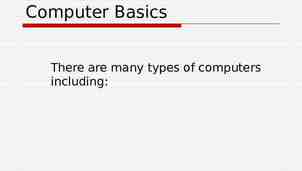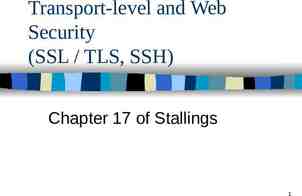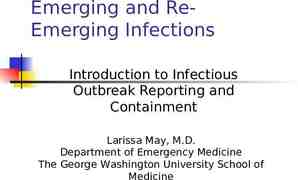Unit 2 Test Review Jennie L. Borders
51 Slides767.85 KB

Unit 2 Test Review Jennie L. Borders

Question 1 Which of the following statements should Paul use as his conclusion from the experiment? A. As air in the bottle is heated, the electrons in air atoms emit heat energy all the way to the top causing the balloon to inflate. As air is cooled, the electrons radiate heat outside the balloon causing it to deflate. B. As air in the bottle is heated, the molecules of air move faster, expand, and reduce density, so they rise and inflate the balloon. As air is cooled, the molecules slow down causing the air to contract, deflating the balloon. C. In step 1, warmer air molecules heat cooler air molecules until all the heat travels to the top and enters the balloon. In step 2, cooler air molecules cool off warmer molecules, so that all heat gets out of the balloon. D. In step 1, the heat causes the air molecules to expand and grow, making them to occupy the balloon and inflating it. In step 2, air molecules are cooled, so they return to their normal size, and the balloon deflates. B

Question 2 Which of the following BEST demonstrates the conversion of nuclear energy into electrical energy? A. Friction of water molecules in a cloud causes a large buildup of electrons in one area. When the voltage is large enough, a lightning bolt occurs. B. In a hydroelectric dam, a large amount of water molecules flows downward from a water reservoir, turning turbines that generate electricity. C. A fully charged battery is attached to a closed electrical circuit, causing electrons to flow through the circuit. D. A reactor generates heat by splitting uranium, creating steam that turns turbines to generate electricity. D

Question 3 Based on the table, which substance would be the BEST conductor of thermal energy and why? A. chromium; because it is a transition metal with the highest specific heat value B. copper; because it is a transition metal and is used in plumbing for hot water lines C. iron; because it is a transition metal that is widely used in construction materials D. silver; because it is a transition metal with the lowest specific heat value Table of Specific Heat Capacities Metal Specific Heat (J/g* C) Iron 0.45 Copper 0.38 Silver 0.24 Chromium 0.46 D

Question 4 Marcus wants to investigate how thermal energy can be transferred by convection. Which of the following scenarios would be a reasonable investigation? A. Studying the transfer of heat by sticking a metal spoon into a cup of hot water to determine if the handle of the spoon will heat up or not. B. Studying the transfer of heat by taking the temperature of the air beside a fire and farther away from a fire to determine how far away the heat can be detected. C. Studying the transfer of heat by measuring the temperature of the water at the top of a body of water and at the bottom to determine which way the warm water will flow. D. Studying the transfer of heat by taking the temperature on the outside and the inside of a wooden door facing the sun to determine if the heat can move through the door. C

Question 5 Which of the following is the energy transformation that occurs when gasoline is burned to power a car? A. heat energy to sound energy B. chemical energy to sound energy C. heat energy to mechanical energy D. chemical energy to mechanical energy D

Question 6 When does the addition of heat result in a rapid temperature rise? A. When the material has a low latent heat of vaporization. B. When the material has a high latent heat of vaporization. C. When the material has a low specific heat. D. When the material has a high specific heat. C

Question 7 Which of the following actions could a person do to show how heat moves through conduction? A. A camper melts some marshmallows by holding them over a campfire. B. A person turns the heater on to warm up on a cold evening. C. A chef waits as pasta noodles rise and fall in a pot of boiling water. D. A farmer heats up a metal rod to use as a brand by placing it into a fire. D

Question 8 Based on the graph, which scenario releases the greatest amount of heat? A. Allowing 1 g of boiling water at 100oC to cool to 0oC. B. Allowing 1 g of steam at 140oC to cool to steam at 100oC. C. Allowing 1 g of steam at 100oC to condense to liquid water at 100oC. D. Allowing 1 g of liquid water at 0oC to cool to solid ice at -20oC. C

Question 9 What is the boiling point of this substance? A. 10oC B. 25oC C. 40oC D. 60oC C

Question 10 Which of the following does this model demonstrate? A. diffraction B. refraction C. interference D. reflection A

Question 11 Which wave phenomenon is depicted by the diagram? A. interference B. refraction C. diffraction D. reflection B

Question 12 Which of the following models depicts changes in sound waves that would occur as an ambulance moves AWAY from a hospital with its siren on? A. C. B. D. B

Question 13 How did the pitch of the firetruck’s siren change as perceived by observer B when it passed him? A. The pitch increased. B. The pitch decreased. B C. The pitch remained the same, and only the volume changed. D. The pitch remained the same, and only the speed of the wave changed.

Question 14 Which energy transformation occurs when a battery is put in a flashlight and the flashlight is turned on? A. chemical energy to electrical energy B. electrical energy to chemical energy C. mechanical energy to electrical energy D. electrical energy to mechanical energy A

Question 15 Through which substance would sound travel the slowest? A. gelatin B. water C. wood D. air D

Question 16 Using the data, explain which material would be BEST to include in a lunchbox designed to keep food cold for long periods of time? A. The best material to use is rubber, since it is the best conductor. B. The best material to use is rubber, since it is the best insulator. C. The best material to use is foam, since it is the best conductor. D. The best material to use is foam, since it is the best insulator. D

Question 17 How can the arrow be used to demonstrate the conservation of energy? A. It will have the same total energy just before impact as when it was released. B. Its potential energy will be destroyed once it is released from the bow. C. Its kinetic energy will be destroyed once it reaches the target. D. It will create new energy when it strikes the target. A

Question 18 Which of the following situations does NOT adhere to the law of conservation of energy? A. A ball rolled up a hill has the same amount of total energy at the bottom of the hill as it does when it gets to the top of the hill. B. A book dropped from a person’s hand has the same amount of potential energy in the person’s hand as it does on the ground. C. A chemical is burned, and its energy is not lost but instead released into another form. D. A metal cord carrying electrical energy transforms that B energy into heat energy.

Question 19 As electricity flows through a copper wire, the temperature of the wire increases. Some parts of the wire get warmer than others, but over time the wire is the same temperature from end to end. What kind of heat transfer takes place to make the wire a uniform temperature? A. conduction B. radiation C. convection D. advection A

Question 20 When Emily’s family went camping, her dad built a fire in the middle of the campsite. Which two forms of energy does the burning fire release? A. magnetic energy and nuclear energy B. light energy and heat energy C. mechanical energy and chemical energy D. electrical energy and mechanical energy B

Question 21 For object A to have a higher absolute temperature than object B, which of the following characteristics must object A have? A. greater specific heat B. higher average potential energy C. greater mass D. higher average kinetic energy D

Question 22 The speed of a sound wave through air is about 340 m/s. Which of the following could be the speed of a sound wave through water? A. 1400 m/s B. 340 m/s C. 170 m/s D. Sound waves cannot travel through water. A

Question 23 When sound travels through air, the air particles vibrate A. parallel to the direction of the wave. B. in all different directions. C. perpendicular to the direction of the wave. D. in a circular motion. A

Question 24 The process by which aquatic life forms at the bottom of the ocean can get the oxygen they need to live is related to which type of heat transfer? A. conduction B. convection C. radiation D. a combination of all three B

Question 25 What would MOST LIKELY happen if the gap in the barrier was made larger? A. The amount of diffraction would increase because the opening in the barrier is larger than the wavelength. B. The amount of diffraction would decrease because the opening in the barrier is larger than the wavelength. C. The amount of diffraction would increase because the opening in the barrier is smaller than the wavelength. D. The amount of diffraction would decrease because the opening in the barrier is smaller than the wavelength. B

Question 26 If 127.8 J of heat is added to a 4.0 gram sample of iron metal and the temperature of the metal increases from 25oC to 97oC, what is the specific heat of iron? A. 0.0044 J/goC B. 0.044 J/goC C. 0.44 J/goC D. 4.4 J/goC C

Question 27 Which situation BEST demonstrates the law of conservation of energy? A. ice water transforming into liquid water when it absorbs heat energy B. batteries being able to store potential energy over a long period of time C. a long distance runner conserving her energy to sprint at the end of the race D. the potential energy of a ball being dropped from a cliff being converted to kinetic energy D

Question 28 Ansley places a metal spoon into ice cream and notices the handle of the spoon becomes cold. Which BEST describes how thermal energy is being transferred between the ice cream and the spoon? A. Energy is transferred from the ice cream to the spoon through the process of conduction. B. Energy is transferred from the ice cream to the spoon through the process of convection. C. Energy is transferred from the spoon to the ice cream through the process of conduction. D. Energy is transferred from the spoon to the ice cream C through the process of convection.

Question 29 Which BEST describes radiation heat transfer? A. the transfer of heat due to circulation which is based on changing densities B. the transfer of heat energy from one solid that is in contact with another solid C. the transfer of heat from one location to another through the movement of fluids D. the transfer of heat through electromagnetic waves which does not involve the movement of matter D

Question 30 A 50 gram piece of glass with the specific heat of 0.84 J/goC is heated from 35oC to 46oC. How much heat is added to the glass? A. 11 J B. 193 J C. 462 J D. 1470 J C

Question 31 A source of sound waves approaches a stationary observer through a uniform medium. Compared to the frequency and wavelength of the emitted sound, the observer would detect waves with which of the following characteristics? A. lower frequency and longer wavelength B. higher frequency and longer wavelength C. lower frequency and shorter wavelength D. higher frequency and shorter wavelength D

Question 32 If the speed of the ray increases as it crosses the boundary, then the path of the ray in the new medium will be MOST LIKELY toward which of the following points? A. W B. X C. Y D. Z C

Question 33 Point A on the standing wave is BEST characterized as A. an antinode resulting from destructive interference. B. a node resulting from constructive interference. C. an antinode resulting from constructive interference. D. a node resulting from destructive interference. D

Question 34 Which of the following diagrams BEST represents the shape of the rope when both pulses are in region AB? A. B. C. D. B

Question 35 Unlike ordinary metal, working solar panels remain cool in strong sunlight. This suggests that the energy from the sunlight hitting the panels is A. being converted into thermal energy. B. not being converted into thermal energy. C. being converted into mechanical energy. D. not being converted into electrical energy. B

Question 36 Which action involves the MOST efficient conversion of electrical energy into thermal energy? A. a light bulb turning on inside an oven B. a dishwasher rinsing dirty dishes with cold water C. an electric mixer spinning to mix ingredients D. an oven coil heating up to bake a cake D

Question 37 How do dams make electricity? A. The force of moving water makes energy that the dam changes into electricity. B. The force of gravity pulling down on the dam creates energy that turns into electricity. C. The light energy hitting the water from the Sun makes energy that the dam can change into electricity. D. The sound energy made by the water moving through the dam creates energy that turns into A electricity.

Question 38 Which of the following statements about how sound waves travel is correct? A. Sound waves travel faster through solids than through liquids. B. Sound waves travel faster through gases than through solids. C. Sound waves travel fastest through liquids and the slowest through solids. D. Sound waves travel the fastest through gases and the slowest through liquids. A

Question 39 Which of the following does the material experience during xy? A. an increase in energy absorption and a phase change B. no change in energy absorption and no phase change C. no change in energy absorption and a phase change D. a decrease in energy absorption and no phase change A

Question 40 In order to power an elevator, a motor must convert electrical energy into which other type of energy? A. thermal energy B. nuclear energy C. light energy D. mechanical energy D

Question 41 Which of the following energy transfers refers to a runner eating a protein bar for energy before a track meet? A. heat energy to mechanical energy B. mechanical energy to electrical energy C. chemical energy to mechanical energy D. thermal energy to electrical energy C

Question 42 If the same amount of energy is added to 25.0 g samples of each of the metals in the chart, which metal will experience the largest temperature change? A. Ca B. Fe C. Ag D. Au Metal Specific heat (J/g C) Calcium (Ca) 0.647 Iron (Fe) 0.449 Silver (Ag) 0.235 Gold (Au) 0.129 D

Question 43 Which type of interference will occur when the pulses in the figure meet? A. no interference B. constructive interference C. total interference D. destructive interference B

Question 44 Which of the following correctly lists the flow of energy on a radio that is operated by a hand crank? A. human muscles crank electricity radio speaker B. radio speaker crank electricity human muscles C. human muscles radio speaker electricity crank D. radio speaker human muscles crank electricity A

Question 45 Which of the following statements is true with regard to the angles of incidence and reflection? A. The angles of incidence and reflection are equal. B. The angle of incidence is greater than the angle of reflection. C. The angle of incidence is less than the angle of reflection. D. The angle of incidence can be greater than or less than the angle of reflection. A

Question 46 A telescope detects a group of stars that are moving away from it. How do the detected waves compare to the waves of the source? A. The detected waves have a lower frequency and longer wavelength. B. The detected waves have a higher frequency and shorter wavelength. C. The detected waves have a lower frequency and shorter wavelength. A D. The detected waves have a higher frequency and longer wavelength.

Question 47 Which letters represent the correct pairing of an incident ray and the reflected ray? A. P and T B. R and T C. R and U D. P and U C

Question 48 A student places a skillet on a stove. After heating for 10 minutes, the student removes the skillet from the stove. Which describes the kinetic energy of the molecules in the skillet? A. The kinetic energy remains the same. B. The kinetic energy increases and then decreases. C. The kinetic energy decreases and then increases. D. The kinetic energy constantly increases. B

Question 49 Which frying pan should Carter use that will heat up and cool down the fastest? A. copper B. iron C. glass D. steel A

Question 50 In a gas-powered lawnmower, the gasoline is converted from chemical energy into which other type of energy? A. mechanical energy B. electrical energy C. nuclear energy D. light energy A






